| SILKYPIX® Developer Studio 3.0 | SOFTWARE MANUAL |
| 8. File Operation | ||||||||
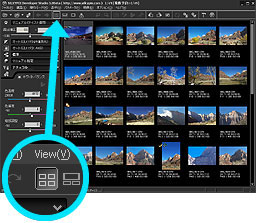 This software supports operations to delete, copy and move the scene which is displayed in the thumbnail mode or the combination mode.
This software supports operations to delete, copy and move the scene which is displayed in the thumbnail mode or the combination mode.8.1 Delete Procedures
There are two ways to delete, one is to delete the reserved scenes, and the other is to delete selected scenes.
8.1.1 Delete Reserved Scene
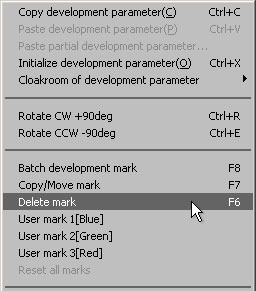 In order to delete a scene, you can put the "delete mark" as the reservation mark to delete. To put the "delete mark", display the pop-up menu by right-clicking on the thumbnail and select the menu command "Delete mark".
In order to delete a scene, you can put the "delete mark" as the reservation mark to delete. To put the "delete mark", display the pop-up menu by right-clicking on the thumbnail and select the menu command "Delete mark".
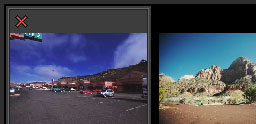 The "delete mark" is the reservation mark to delete. When you put this mark, the scene will not be deleted at this moment.
The "delete mark" is the reservation mark to delete. When you put this mark, the scene will not be deleted at this moment.
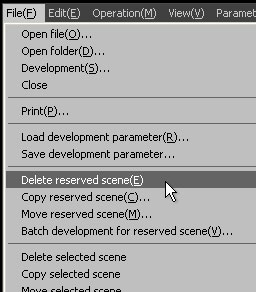 After attaching the "delete mark" to all of the scenes which you want to delete, the menu command [File(F)]-[Delete reserved scene] throws away the marked scenes to the trash box.
After attaching the "delete mark" to all of the scenes which you want to delete, the menu command [File(F)]-[Delete reserved scene] throws away the marked scenes to the trash box.
8.1.2 Delete Selected Scene
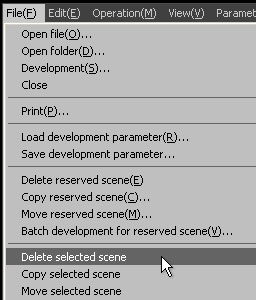 After selecting all of the scenes which you want to delete, the menu command [File(F)]-[Delete selected scene] or [Delete] key throws away the selected scenes to the trash box.
After selecting all of the scenes which you want to delete, the menu command [File(F)]-[Delete selected scene] or [Delete] key throws away the selected scenes to the trash box.
By executing these two operations, you can move the scenes into the trash box. In other words, the scenes are not deleted completely, and you can restore them from the trash box later. If you want to delete them completely, please execute the menu command or the shortcut key action while pressing the {SHIFT] key.
8.1.1 Delete Reserved Scene
 In order to delete a scene, you can put the "delete mark" as the reservation mark to delete. To put the "delete mark", display the pop-up menu by right-clicking on the thumbnail and select the menu command "Delete mark".
In order to delete a scene, you can put the "delete mark" as the reservation mark to delete. To put the "delete mark", display the pop-up menu by right-clicking on the thumbnail and select the menu command "Delete mark". The "delete mark" is the reservation mark to delete. When you put this mark, the scene will not be deleted at this moment.
The "delete mark" is the reservation mark to delete. When you put this mark, the scene will not be deleted at this moment. After attaching the "delete mark" to all of the scenes which you want to delete, the menu command [File(F)]-[Delete reserved scene] throws away the marked scenes to the trash box.
After attaching the "delete mark" to all of the scenes which you want to delete, the menu command [File(F)]-[Delete reserved scene] throws away the marked scenes to the trash box. After selecting all of the scenes which you want to delete, the menu command [File(F)]-[Delete selected scene] or [Delete] key throws away the selected scenes to the trash box.
After selecting all of the scenes which you want to delete, the menu command [File(F)]-[Delete selected scene] or [Delete] key throws away the selected scenes to the trash box.8.2 Copy/Move Procedures
8.2.1 Copy/Move Reserved Scene
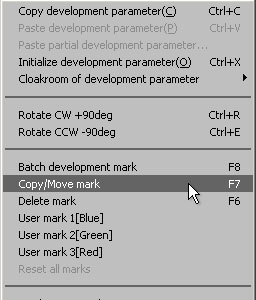 In order to copy/move a scene, you can put the "copy/move mark" as the reservation mark to copy/move. To put the "copy/move mark", display the pop-up menu by right-clicking on the thumbnail and select the menu command "Copy/Move mark".
In order to copy/move a scene, you can put the "copy/move mark" as the reservation mark to copy/move. To put the "copy/move mark", display the pop-up menu by right-clicking on the thumbnail and select the menu command "Copy/Move mark".
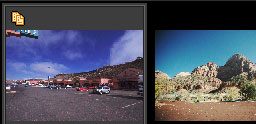 The "copy/move mark" is the reservation mark to copy/move. When you put this mark, the scene will not be copied/moved at this moment.
The "copy/move mark" is the reservation mark to copy/move. When you put this mark, the scene will not be copied/moved at this moment.
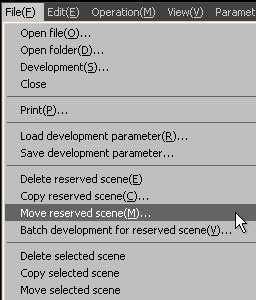 To move the marked scenes, execute [File(F)]-[Move reserved scene] and then specify the folder into which the scenes are moved.
To move the marked scenes, execute [File(F)]-[Move reserved scene] and then specify the folder into which the scenes are moved.
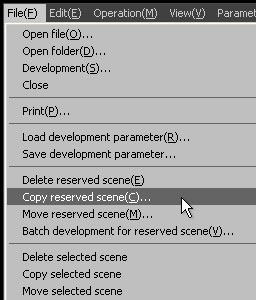 To copy the marked scenes, execute [File(F)]-[Copy reserved scene] and then specify the folder into which the scenes are copied.
To copy the marked scenes, execute [File(F)]-[Copy reserved scene] and then specify the folder into which the scenes are copied.
8.2.2 Copy/Move Selected Scene
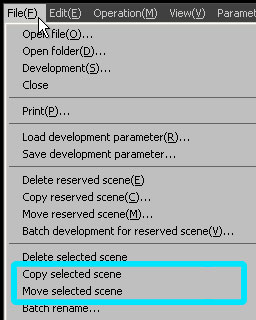 To copy/move the selected scenes, execute [File(F)]-[Copy selected scene] or [Move selected scene] and specify the folder into which the scenes are copied/moved.
To copy/move the selected scenes, execute [File(F)]-[Copy selected scene] or [Move selected scene] and specify the folder into which the scenes are copied/moved.
 In order to copy/move a scene, you can put the "copy/move mark" as the reservation mark to copy/move. To put the "copy/move mark", display the pop-up menu by right-clicking on the thumbnail and select the menu command "Copy/Move mark".
In order to copy/move a scene, you can put the "copy/move mark" as the reservation mark to copy/move. To put the "copy/move mark", display the pop-up menu by right-clicking on the thumbnail and select the menu command "Copy/Move mark". The "copy/move mark" is the reservation mark to copy/move. When you put this mark, the scene will not be copied/moved at this moment.
The "copy/move mark" is the reservation mark to copy/move. When you put this mark, the scene will not be copied/moved at this moment. To move the marked scenes, execute [File(F)]-[Move reserved scene] and then specify the folder into which the scenes are moved.
To move the marked scenes, execute [File(F)]-[Move reserved scene] and then specify the folder into which the scenes are moved. To copy the marked scenes, execute [File(F)]-[Copy reserved scene] and then specify the folder into which the scenes are copied.
To copy the marked scenes, execute [File(F)]-[Copy reserved scene] and then specify the folder into which the scenes are copied. To copy/move the selected scenes, execute [File(F)]-[Copy selected scene] or [Move selected scene] and specify the folder into which the scenes are copied/moved.
To copy/move the selected scenes, execute [File(F)]-[Copy selected scene] or [Move selected scene] and specify the folder into which the scenes are copied/moved.8.3 Files to be Deleted, Copied, or Moved
Since this software is compatible with the DCF (Design rule for Camera File system) Standard which has been adopted into the most digital cameras, the multiple files that have the same base name are handled as the identical group of images.
For example, if four files such as IMAG0001.CRW, IMAG0001.JPG, IMAG0001.THM, and IMAG0001.SPD exist in the same folder, these four files are handled as a group at the time of operation.
In other words, when you delete an IMAG0001, these four files are deleted as a group. So the same thing happens at the time of copying and moving.
In the DCF Standard, it is prescribed that the files that have the same base name are handled as a group.
For example, the file is composed in the output media as follows by the camera which is being based on this standard.
IMAG0002.RAW ... RAW file
IMAG0002.JPG ... JPG file created with RAW file simultaneously
IMAG0002.THM ... Thumbnail file
IMAG0002.WAV ... Sound clip associated with scene
SILKYPIX® writes the development parameters in the file named "IMAG0002.RAW.SPD" and a thumbnail file "IMAG0002.RAW.SPI" into the "SILKYPIX_DS" sub-folder.
These files created into the "SILKYPIX_DS" sub-folder are treated as members of the group, too.
You can treat these files as a group by other utility which was based on the DCF standard, too. But please remember that if you operate these files by other utility, the files created into the "SILKYPIX_DS" sub-folder by SILKYPIX® will not be handled as a group.
For example, if four files such as IMAG0001.CRW, IMAG0001.JPG, IMAG0001.THM, and IMAG0001.SPD exist in the same folder, these four files are handled as a group at the time of operation.
In other words, when you delete an IMAG0001, these four files are deleted as a group. So the same thing happens at the time of copying and moving.
In the DCF Standard, it is prescribed that the files that have the same base name are handled as a group.
For example, the file is composed in the output media as follows by the camera which is being based on this standard.
IMAG0002.RAW ... RAW file
IMAG0002.JPG ... JPG file created with RAW file simultaneously
IMAG0002.THM ... Thumbnail file
IMAG0002.WAV ... Sound clip associated with scene
SILKYPIX® writes the development parameters in the file named "IMAG0002.RAW.SPD" and a thumbnail file "IMAG0002.RAW.SPI" into the "SILKYPIX_DS" sub-folder.
These files created into the "SILKYPIX_DS" sub-folder are treated as members of the group, too.
You can treat these files as a group by other utility which was based on the DCF standard, too. But please remember that if you operate these files by other utility, the files created into the "SILKYPIX_DS" sub-folder by SILKYPIX® will not be handled as a group.
8.4 Save Parameter and Thumbnail into CD/DVD
This software creates a development parameter file and a thumbnail file into the folder "SILKYPIX_DS", which is created automatically in the folder that the RAW data file exists. (*1)
When you copy RAW files into a CD/DVD, you can save the development parameter and the thumbnail image of SILKYPIX® by copying these files together.
If a thumbnail file is saved together, when you view directly from CD/DVD with this software, a thumbnail file can be displayed quickly.
We recommend you to save "SILKYPIX_DS" sub-folder together when you save the RAW data files into a CD/DVD.
Please refer to '10.4.3 Files Created Automatically'.
A thumbnail file is created automatically in the background process while you are viewing a thumbnail in the thumbnail mode or the combination mode.
However, a thumbnail file is created only when the scene is browsed in the thumbnail mode or the combination mode. In order to create all thumbnails that exist in a certain folder, you can execute the following procedures.
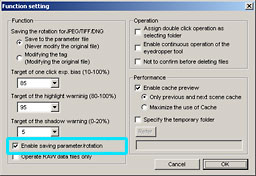 (1) Enable [Enable saving parameter/rotation] on the "Function setting" dialog to allow creating parameter/thumbnail files.
(1) Enable [Enable saving parameter/rotation] on the "Function setting" dialog to allow creating parameter/thumbnail files.
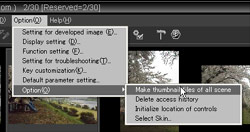 (2) Open the folder in which you want to create a thumbnail file and execute the menu command [Option(O)]-[Option(O)]-[Make thumbnail files of all scene].
(2) Open the folder in which you want to create a thumbnail file and execute the menu command [Option(O)]-[Option(O)]-[Make thumbnail files of all scene].
When you copy RAW files into a CD/DVD, you can save the development parameter and the thumbnail image of SILKYPIX® by copying these files together.
If a thumbnail file is saved together, when you view directly from CD/DVD with this software, a thumbnail file can be displayed quickly.
We recommend you to save "SILKYPIX_DS" sub-folder together when you save the RAW data files into a CD/DVD.
Please refer to '10.4.3 Files Created Automatically'.
A thumbnail file is created automatically in the background process while you are viewing a thumbnail in the thumbnail mode or the combination mode.
However, a thumbnail file is created only when the scene is browsed in the thumbnail mode or the combination mode. In order to create all thumbnails that exist in a certain folder, you can execute the following procedures.
 (1) Enable [Enable saving parameter/rotation] on the "Function setting" dialog to allow creating parameter/thumbnail files.
(1) Enable [Enable saving parameter/rotation] on the "Function setting" dialog to allow creating parameter/thumbnail files. (2) Open the folder in which you want to create a thumbnail file and execute the menu command [Option(O)]-[Option(O)]-[Make thumbnail files of all scene].
(2) Open the folder in which you want to create a thumbnail file and execute the menu command [Option(O)]-[Option(O)]-[Make thumbnail files of all scene]. | *1 ... You can disable this function. For details, refer to '9.3.1.5 Enable Saving Parameter/Rotation'. |
8.5 Rename/Batch Rename
There are two ways to rename a file.
Only a base name (a file name without extension) can be renamed and cannot be renamed an extension part.
The file that has the same base name with a different extension and exists in the same folder is also renamed simultaneously.
[How to Use Rename]
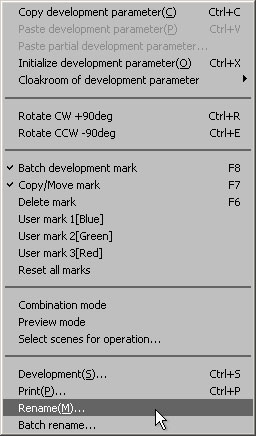 When a scene is selected in the thumbnail mode, you can display context menu by right-clicking on that scene. Then select [Rename(M)] to display the control box for renaming that scene.
When a scene is selected in the thumbnail mode, you can display context menu by right-clicking on that scene. Then select [Rename(M)] to display the control box for renaming that scene.
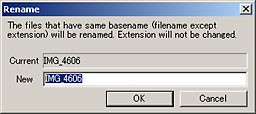 You can rename the file by inputting the base name that you want to use in the control box.
You can rename the file by inputting the base name that you want to use in the control box.
[How to Use Batch Rename]
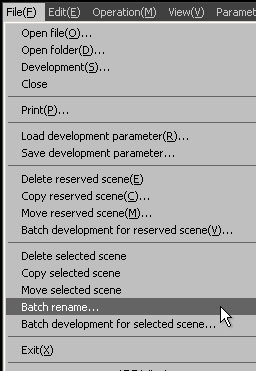 When some scenes are selected in the thumbnail mode or the combination mode, the menu [File(F)]-[Batch Rename] displays the "Batch rename" dialog.
When some scenes are selected in the thumbnail mode or the combination mode, the menu [File(F)]-[Batch Rename] displays the "Batch rename" dialog.
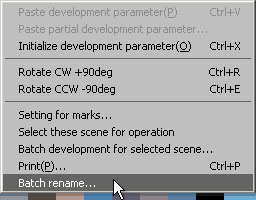 You can also display the "Batch rename" dialog by selecting [Batch rename] in the context menu. By inputting the base name that you want to use in this dialog, you can rename the files that have the same base name and exist in the same folder collectively.
You can also display the "Batch rename" dialog by selecting [Batch rename] in the context menu. By inputting the base name that you want to use in this dialog, you can rename the files that have the same base name and exist in the same folder collectively.
[How to Use Batch Rename Dialog]
* Rename
* Batch Rename
When you rename a file, the following rule is applied to the both cases Rename/Batch rename. * Batch Rename
You can use this function when multiple scenes are selected in the thumbnail mode or the combination mode.
Only a base name (a file name without extension) can be renamed and cannot be renamed an extension part.
The file that has the same base name with a different extension and exists in the same folder is also renamed simultaneously.
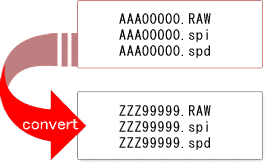 |
[How to Use Rename]
 When a scene is selected in the thumbnail mode, you can display context menu by right-clicking on that scene. Then select [Rename(M)] to display the control box for renaming that scene.
When a scene is selected in the thumbnail mode, you can display context menu by right-clicking on that scene. Then select [Rename(M)] to display the control box for renaming that scene.  You can rename the file by inputting the base name that you want to use in the control box.
You can rename the file by inputting the base name that you want to use in the control box.  When some scenes are selected in the thumbnail mode or the combination mode, the menu [File(F)]-[Batch Rename] displays the "Batch rename" dialog.
When some scenes are selected in the thumbnail mode or the combination mode, the menu [File(F)]-[Batch Rename] displays the "Batch rename" dialog. You can also display the "Batch rename" dialog by selecting [Batch rename] in the context menu. By inputting the base name that you want to use in this dialog, you can rename the files that have the same base name and exist in the same folder collectively.
You can also display the "Batch rename" dialog by selecting [Batch rename] in the context menu. By inputting the base name that you want to use in this dialog, you can rename the files that have the same base name and exist in the same folder collectively. (1) Setting Rename Rule
Specify base name in each 3 part, "[Area-A]", "[Area-B]", and "[Area-C]."
When the control character area A is used, [Base], [Focal lengthen], [F number], [Shutter speed], [ISO speed], [Date], and [Time] button input the corresponding control character automatically.
When the [Init.] button is clicked, area A is initialized. The control character can be inputted directly from your keyboard using conventional name.
*1 There are the control characters for batch rename. (This is the same control character as for "Default filename to save".)
(2) Processing the same file name| [Area-A] | : | Specifies optional word. |
| [Area-B] | : | Selects from the prepared word. |
| [Area-C] | : | Specifies digit number of sequential number and the first figure. |
When the [Init.] button is clicked, area A is initialized. The control character can be inputted directly from your keyboard using conventional name.
*1 There are the control characters for batch rename. (This is the same control character as for "Default filename to save".)
| %N | ... | Basename of the RAW data file ("Basename" means a part of filename except the extension) |
| %I | ... | ISO Speed |
| %L | ... | Focal Length |
| %F | ... | F Number |
| %T | ... | Shutter Speed |
| %Y | ... | Date Time - Year (2 digit) |
| %y | ... | Date Time - Year (4 digit) |
| %M | ... | Date Time - Month |
| %D | ... | Date Time - Day |
| %h | ... | Date Time - Hour |
| %m | ... | Date Time - Minute |
| %s | ... | Date Time - Seconds |
| %% | ... | Method of describing '%' |
When the same filename exists even after being renamed, you can select either to expand the file name automatically or display the confirm dialog every time.
(3) Specifying letter case of extensionSpecify to use capital letters or small letters for an extension. You can specify either not to change the present one or change into capital letters or small letters.
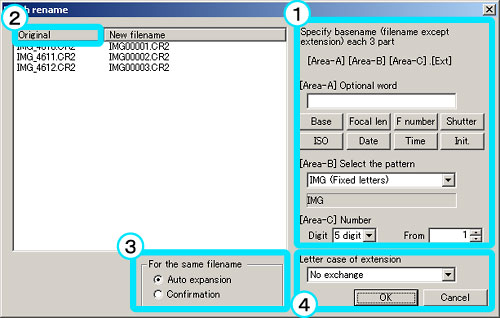 "Batch rename" Dialog |
8.6 Printing
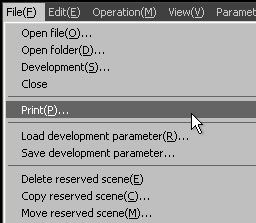 This function prints the scene which is operated in the preview mode, or the scenes which are selected in the thumbnail mode or the combination mode.
This function prints the scene which is operated in the preview mode, or the scenes which are selected in the thumbnail mode or the combination mode. This function has two printing format, one is "Normal printing" that prints one scene on one sheet, the other is "Contact sheet" that prints multiple scenes on one sheet.
The menu command [File(F)]-[Print(P)] displays the "Print" dialog
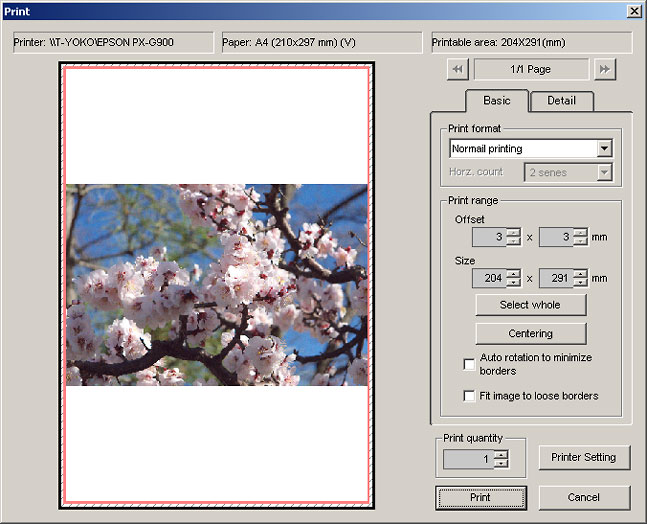 |
8.6.1 Basic Setting
8.6.1.1 Print Format
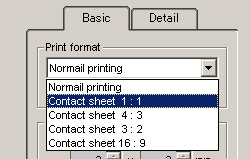 You can specify the print format. There are two type of format, one is "Normal printing" that prints one scene on one sheet, and the other is "Contact sheet" that prints multiple scenes on one sheet.
You can specify the print format. There are two type of format, one is "Normal printing" that prints one scene on one sheet, and the other is "Contact sheet" that prints multiple scenes on one sheet.
If you select "Contact sheet", you can select the aspect ratio of the frame for each scene, which is 1:1, 4:3, 3:2, or 16:9.
• Number of Horizontal Scenes
When the contact sheet is selected, you can specify the number of scenes to be located on one horizontal line, the range is between 2-20 scenes.
8.6.1.2 Print Range
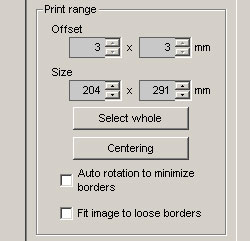 [Set the Print Range]
[Set the Print Range]
8.6.2 Detail Setting You can specify the print format. There are two type of format, one is "Normal printing" that prints one scene on one sheet, and the other is "Contact sheet" that prints multiple scenes on one sheet.
You can specify the print format. There are two type of format, one is "Normal printing" that prints one scene on one sheet, and the other is "Contact sheet" that prints multiple scenes on one sheet.If you select "Contact sheet", you can select the aspect ratio of the frame for each scene, which is 1:1, 4:3, 3:2, or 16:9.
• Number of Horizontal Scenes
When the contact sheet is selected, you can specify the number of scenes to be located on one horizontal line, the range is between 2-20 scenes.
 [Set the Print Range]
[Set the Print Range]You can specify the print range if you select "Normal printing".
• Offset from the top left (mm)
[Arrangement Setting]• Offset from the top left (mm)
Please specify the offset from the top left of the sheet.
• Size of the print area (mm)Please specify the size of the printed area.
Printing location of each scene is automatically adjusted in this area.
• [Select whole] buttonPrinting location of each scene is automatically adjusted in this area.
It makes a print area the whole sheet.
• [Centering] buttonIt puts a print area in the center in the sheet.
You can specify how to arrange the location of each scene in the print area.
• [Auto rotation to minimize borders]
• [Auto rotation to minimize borders]
If you enable this feature, the image is automatically rotated to minimize the borders.
• [Fit image to loose border]If you disable this feature, the image is located inscribed area of the print frame. It makes a border area usually.
If you enable this feature, the image is located circumscribed area of the print frame. The image will be trimmed usually.
If you enable this feature, the image is located circumscribed area of the print frame. The image will be trimmed usually.
8.6.2.1 Unsharp Mask
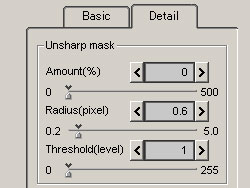 This feature allow you to do unsharp mask filter to the developed image additionally. You can adjust unsharp mask with amount(%), radius(pixel) and threshold value(level).
This feature allow you to do unsharp mask filter to the developed image additionally. You can adjust unsharp mask with amount(%), radius(pixel) and threshold value(level).
Please use this feature apart from the sharpness of the development parameter if you want to make up the sharpness to measure to the blur of printing.
The "sharpness" of the development parameter should be adjusted for each scene to increase resolution.
The other hand, the "unsharp mask" is the common parameter for printing.
Please refer to '10.1.10 How to Use Sharp and Unsharp Mask' for more details.
• Amount(%)
8.6.2.2 Print Quality
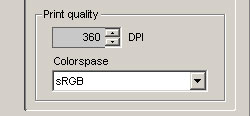 • Print Resolution
• Print Resolution
8.6.3 Print Quantity This feature allow you to do unsharp mask filter to the developed image additionally. You can adjust unsharp mask with amount(%), radius(pixel) and threshold value(level).
This feature allow you to do unsharp mask filter to the developed image additionally. You can adjust unsharp mask with amount(%), radius(pixel) and threshold value(level).Please use this feature apart from the sharpness of the development parameter if you want to make up the sharpness to measure to the blur of printing.
The "sharpness" of the development parameter should be adjusted for each scene to increase resolution.
The other hand, the "unsharp mask" is the common parameter for printing.
Please refer to '10.1.10 How to Use Sharp and Unsharp Mask' for more details.
• Amount(%)
You can specify the "amount" to apply "unsharp mask". The larger value makes the stronger sharpness.
• Radius(pixel)It sets the thickness of the edge of the outline emphasized.
The larger value makes the thicker edge, and the smaller value makes the thinner edge.
Typically, setting the range between 0.5-1.0 is recommended.
• Threshold(level)The larger value makes the thicker edge, and the smaller value makes the thinner edge.
Typically, setting the range between 0.5-1.0 is recommended.
If the value is set smaller, the outlines are emphasized regardless of the clearness of the edge.
If the value is set larger, only the outlines are emphasized which has clear edge.
You can prevent the emphasis of the noise with this parameter.
Typically it is set to '0'. Please adjust this parameter to balance noise and sharpness.
If the value is set larger, only the outlines are emphasized which has clear edge.
You can prevent the emphasis of the noise with this parameter.
Typically it is set to '0'. Please adjust this parameter to balance noise and sharpness.
 • Print Resolution
• Print ResolutionPlease specify the print resolution.
SILKYPIX® expands/reduces an image according to the print resolution, which is sent to the printer. If you set larger value, SILKYPIX® makes larger image which is sent to the printer.
The larger value makes the better quality of printing but makes larger image data and required larger memory.
• ColorspaceSILKYPIX® expands/reduces an image according to the print resolution, which is sent to the printer. If you set larger value, SILKYPIX® makes larger image which is sent to the printer.
The larger value makes the better quality of printing but makes larger image data and required larger memory.
You can specify the colorspace for printing, which is sRGB or Adobe RGB. In general sRGB is selected.
If you select "Adobe RGB", you have to do appropriate printer setting. It means that you have to enable the color management of the printer and have to specify "Adobe RGB" as an input colorspace.
Please refer to the printer manual about the color management of the printer.
If you select "Adobe RGB", you have to do appropriate printer setting. It means that you have to enable the color management of the printer and have to specify "Adobe RGB" as an input colorspace.
Please refer to the printer manual about the color management of the printer.
 You can specify the number of copies here.
You can specify the number of copies here.When the "Printer Setting" button is clicked, the OS standard the "Printer Setting" dialog will be displayed.
Please complete the printer setting.
8.6.5 Print ExecutionPlease complete the printer setting.
• Print Execution
8.6.6 Print Preview of Multiple ScenesClick the "Print" button to print with the current setting.
• Print CancellationClick the "Cancel" button to close the dialog without print operation.
If you select multiple scenes in the thumbnail mode or the combination mode, you will print multiple pages as one copy.
In this case, you can change preview page by clicking the buttons, which are located in both sides of the page area.
In this case, you can change preview page by clicking the buttons, which are located in both sides of the page area.